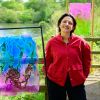
George Moody
- Course: MA Performance Design
Please tell us a bit about yourself and your current career
I am a multi-disciplinary artist, based in Leeds, with a practice spanning bio-art, sculpture, installation and digital technology. My work is driven by the ideas of Queer Ecology (the combination of Queer Theory and Ecocriticism), creating works that challenge our conceptions of nature as mute and passive to the climate crisis. I use performance design techniques developed during the MA to elevate the existing performativity of ecological materials.
Currently, I am working on a new project exploring living ‘archives’ of weeds in states of decomposition. I am developing a technique for curing bioplastics that will allow the decay-inducing bacteria of the weeds to transfer to the bioplastics; altering the composition of each piece and eventually disintegrating them. I am also developing bioplastic workshops that will include a queer ecological walk and forage for materials. As an emerging artist continuing to establish my portfolio, I am seeking further residency and funding opportunities to push my work further and collaborate with others.
What have you been up to since graduating from Leeds?
Since graduating, I have gained experience working at the Hepworth Wakefield, the Henry Moore Institute and currently in the Leeds Textiles and Colour Institute, as part of the School of Design. In November 2023, I debuted a living slime mold installation IT ENDS WITH YOU at Leeds Light Night which received a highly positive reception. Since then I have been working from my studio to explore the potential of bioplastics as a sustainable material, with a witnessable life span and potential to collaborate with microbiological others.
I am the recipient of the Yorkshire Sculpture Park’s Graduate award for 2024, which included funding to develop new work and a two week on site residency with a public showing in May, 2025. The residency has been an invaluable opportunity to develop my practice and artistic voice. I hope to take the work I do there further into development, public installations and exhibitions.
How do you think the skills and knowledge you developed at Leeds helped with your career success?
One of the key takeaways from the programme that has helped my journey thus far, was the confidence to explore and play in the process of making. The programme installed an instinct for curiosity that allowed new ideas and work to develop organically with a strong connection to the theories that informed it. Particularly in the praxis module, the opportunity to work in a material-led approach prompted me to ask questions and grow ideas that I may not have got to through other routes.
What made you want to apply to your course and to Leeds?
I wanted to apply for this course because new materiality had become a central research interest from my time studying a BA in Art history. I got in touch with the course director and had a great conversation with them about the course content which sounded relevant and exciting. I also believed that performance art was an incredibly useful tool for interrogating the world we live in and I wanted to explore designing for performance, spatially and through materials. I had existing connections to Leeds both as my place of study for my BA but also as a Live Art producer for the Centre for Live Art Yorkshire. Studying this course part time allowed me to study and develop my career synonymously.
What aspects of the course did you enjoy the most?
I liked the diversity of pieces explored in the critical concepts module, which offered a multidisciplinary review of performance design, from installation art, theatre design, outdoor works of art. Linking works by themes such as agency instead of by medium really helped to expand my ideas of making and prevented me from confining my work. I also particularly enjoyed the independent projects that allowed you to follow your own instinct whilst having supervisors who are experts in the field to support you.
What would you say about the learning and the support facilities in your School and at the University in general?
There is a huge range of learning and support facilities offered in the School as well as the university. The facilities available at the school of PCI were incredibly useful as it allowed you to test out new ideas in full scale with an excellent lighting system.
The library services were particularly useful for helping me to compound my knowledge and take it in new directions. I was always drawn to the vast range of books and resources available at the brotherton library which was also a beautiful setting to get stuck into them. The library was also highly supportive in procuring new digital books and articles on request if they were useful to your research. I was able to gain access to newly published works that would have otherwise been impossible and stay up to date in my research development.
What would you say to anyone thinking of applying to your course?
I’d say it is a broad course that will allow you to carve out your own specialism whilst gathering a comprehensive understanding of contemporary and historical performance design. It is a good balance of both practical and theoretical work that would appeal to someone who wants to allow both to feed into each other. It is a challenging course that will push you to think independently and consider how your work will impact audiences. Studying In Leeds also allows you to be a part of a rich creative community with great opportunities to get involved in projects that push your development further.

